|
| |
|
|
|
Lemurs of Madagascar
If you have heard anything at all about Madagascar , you have heard about lemurs. « We admire the world through what we love » said Lamartine. And it's true. All people, all tourists who have seen lemurs in their nature environment in Madagascar have had an amazing look of them. Unfortunately they are threatened by a host of environmental problems, including deforestation ( creation of pasture for cattle through burning, gathering of wood for firewood and charcoal production, and the illegal logging of precious hardwoods for foreign markets = 2009, 2010 ), hunting for bushmeat, live capture for the exotic pet trade and climate change.
|
|
|
|
|
|
|
|
|
|
|
|
|
|
|
|
|
|
|
|
|
|
 |
The Mascot of the 3rd Indian Ocean Islands Games - 1990 - Madagascar. The Ringtailed Lemur - Drawing of Mrs Rakotondrazaka Vololomanantsoa
We admire the world
through what we love
( Lamartine ) |
![Northern sportive lemur at Ankarana reserve -
Family Lempilemuridae - [ Ravo Madagascar ] lemur of Madagascar](Maky%20D.jpg) |
|
Lemur who is an order of primate and who is an endangered species is endemic to the island of Madagascar,
And they are a class of mammalia. Today there are nearly 100 species of lemurs currently recognised ( most of those species were discovered or promoted to full species status since the 1990s ).
More than 15 species have disappeared because of the destruction of their environment : the forest. They have disappeared about 1500 years ago, date when the first men came in Madagascar ( the original country of all lemurs ). Examples : the biggest lemur that ever lived : the Archaeoindris ( from 160 to ... 200 Kg ), the Babakotia & the Megaladapis ( from 40 to 80 Kg ).
Living lemurs range in size from 30 g ( the mouse lemur, the smallest ) to 9 kg ( the Indri Indri teddy-like lemur, the biggest ). Lemurs are generally the most social of primates. Lemurs communicate more with scents and vocalizations than with visual signals.
Lemurs are vegetarian,
Lemurs eat in general fruits and leaves,
Most lemur species excluding some of the indris, predominantly eat fruit ( frugivory ) when available. The lemur diet is dominated by fruit from Ficus ( fig ) species. In many anthropoid primates, fruit is a primary source of vitamin C.
Inflorescences ( clusters of flowers ) of at least 60 plant families are eaten by lemurs ranging in size from the tiny mouse lemurs to the relatively large ruffed lemurs. If the flowers are not exploited, sometimes the nectar is consumed ( nectarivory ) along with the pollen ( palynivory ).
Bark and plant exudates such as tree sap are consumed by a few lemur species. Only the Masoala Fork-marked Lemur ( Phaner furcifer ) and Coquerel's Giant Mouse Lemur regularly consume tree sap. Bark has never been reported as an important food item in lemur diets, but at least four species eat it : the Aye-aye, the Red-tailed Sportive Lemur ( Lepilemur ruficaudatus ), the Common Brown Lemur ( Eulemur fulvus ), and Verreaux's Sifaka ( Propithecus verreauxi ).
Soil consumption has also been reported and likely helps with digestion, provides minerals and salts, and helps absorb toxins. Sifakas have been observed eating soil from termite mounds, possibly adding beneficial intestinal flora to aid the digestion of cellulose from their folivorous diet.
Madagascar : the Tsingy, Nosy Be area, Baobab
Here is the Black and white ruffed lemur
Lemur behavior, lemur social systems are as variable as lemur morphology,
Differences in diet, social systems, activity patterns, locomotion, communication, predator avoidance tactics, breeding systems, and intelligence levels help define lemur taxa and set individual species apart from the rest. Although trends frequently distinguish the smaller, nocturnal lemurs from the larger, diurnal lemurs.
Some lemurs are nocturnal, others are diurnal & others are crepuscular. Some lemurs live in tropical lowland rainforest, others live in montane rainforest ( up to 800 m of altitude ) & others live in deciduous forest or in the South spiny bushes.
All lemurs spend most of their time in the trees except the Ringtailed lemur ( Lemur catta ) which spend most of its time on the ground. The females of lemurs carry their babies with them. Lemurs use their voices, their leggs & their smells to communicate between them. Some of them use their 4 leggs for locomotion but others use acrobatic leaps from tree to tree & use only their two hind leggs with a vertical position when they are on the ground.
Lemurs are social and live in groups that usually include less than 15 individuals. Observed social organization patterns include " solitary but social ", " fission-fusion ", " pair bonds ", and " multi-male group ". For some lemurs, females stay within their natal range and the males migrate upon reaching maturity, and in other species both sexes will migrate.
Like other primates, lemurs groom socially to ease tensions and solidify relationships. They groom in greeting, when waking up, when settling in for sleep, between mother and infant, in juvenile relations, and for sexual advances. Lemurs groom with their tongue.
The presence of female social dominance sets lemurs apart from most other primates and mammals. However, many Eulemur species are exceptions and the Greater Bamboo Lemur ( Prolemur simus ) does not exhibit female dominance.
  
Lemur's wildlife predator avoidance
All lemurs experience some predation pressure. Common defenses against predation include the use of alarm calls and predator mobbing, mostly among diurnal lemurs. Diurnal lemurs are visible during the day, so many live in groups, where the increased number of eyes and ears helps aid in predator detection. Diurnal lemurs use and respond to alarm calls, even those of other lemur species and non-predatory birds.
Nocturnal lemurs are difficult to see and track at night and decrease their visibility by foraging alone. They also try to avoid predators by using concealing sleeping locations, such as nests, tree holes, or dense vegetation, and alternating between multiple sleeping locations. Infants are protected while foraging by either leaving them in the nest or by stashing them in a hidden location, where the infant remains immobile in the absence of the parent.
The Fosa ( the biggest of Malagasy carnivorous = Cryptoprocta ferox ) and the Madagascar Harrier-hawk ( Polyboroides radiatus ) are predators of many lemur species. Other predators are the Madagascar Buzzard ( Buteo brachypterus ), diurnal birds of prey, owls, feral cats, domestic dogs, snakes, crocodiles, and ... human beings.
|
|
|
|
|
|
|
|
|
|
|
|
|
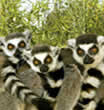   
The Ringtailed lemur - the Indri
the Brown lemur - the Black & White ruffed lemur
Maky - Babakoto - Gidro - Varika
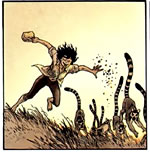
Ringtailed lemurs
Frank & Bonifay
Zoo
There are 5 families of lemurs :
I- Family Cheirogaleidae lemurs
( Dwarf Lemurs, Fork-Marked Lemurs & Mouse Lemurs )
They are quiet, discreet & difficult to observe. These lemurs are small or very small & they are exclusively nocturnal. The day, they sleep in trees holes and cavities. These lemurs eat in general insects and fruits.
In Sportive lemurs and Fork-marked lemurs, one or two females may share a home range, possibly with a male. Dwarf lemurs are solitary but social, foraging alone but often sleeping in groups. Dwarf lemurs are known to hibernate for five months and more every year ( May through September ) particularly on the west coast of Madagascar. Before and after this deep hibernation, there are two months ( April and October ) of transition, where they will forage on a limited basis to reduce demands on their fat reserves.
|
|
|
|
|
|
|
|
|
|
|
|
|
1- Cheirogaleus medius
2- Cheirogaleus major
3- Allocebus trichotis
4- Mirza coquereli
5- Phaner furcifer
6- Microcebus myoxinus
7- Microcebus murinus
8- Microcebus rufus
9- Microcebus ravelobensis
10- Microcebus sambiranensis
11- Microcebus tavaratra
12- Microcebus berthae
13- Microcebus griseorufus
14- Microcebus lehilahytsara
15- Microcebus jollyae
16- Microcebus simmonsi
17- Microcebus mittermeieri
18- Microcebus mamiratra
19- Microcebus lokobensis
20- Microcebus bongolavensis
21- Microcebus danfossi
22- Cheirogaleus crossleyi
23- Cheirogaleus sibreei
24- Cheirogaleus ravus
25- Cheirogaleus minusculus
26- Cheirogaleus adipicaudatus
27- Mirza zaza
28- Phaner parienti
29- Phaner pallescens
30- Phaner electromontis
|
Fat-tailed dwarf lemur
Greater dwarf lemur
Hairy-eared dwarf lemur
Coquerel's giant dwarf lemur
Eastern Fork-marked lemur
Western rufous mouse lemur
Grey mouse lemur
Brown mouse lemur
Golden-brown mouse lemur
Sambirano mouse lemur
Northern rufous mouse lemur
Madame Berthe's mouse lemur
Grey-brown mouse lemur
Goodman's mouse lemur
Jolly's mouse lemur
Simmon's mouse lemur
Mittermeier mouse lemur
Claire's mouse lemur
Lokobe mouse lemur
Bongolava mouse lemur
Danfoss mouse lemur
Furry-eared dwarf lemur
Sibree's dwarf lemur
Greater iron grey dwarf lemur
Lesser iron grey dwarf lemur
Spiny forest dwarf lemur
Northern giant dwarf lemur
Pariente's fork-marked lemur
Pale fork-marked lemur
Amber Mountain fork-marked lemur
|
Petit cheirogale
Grand cheirogale
Allocèbe
Microcèbe de Coquerel
Phaner
Microcèbe pygmé
Petit microcèbe
Microcèbe roux
Microcèbe de Ravelobe
Microcèbe du Sambirano
Microcèbe du Nord
Microcèbe de Mme Berthe
Microcèbe gris
Microcèbe de Jolly
Microcèbe de Simmon
Microcèbe de Mittermeier
Microcèbe de Lokobe
Microcèbe du Bongolava
Microcèbe de Danfoss
Cheirogale de Sibree
Phaner de Pariente
Phaner de la Montagne d'A.
|
|
II- Family Lepilemuridae ( Sportive Lemurs ) :
They are too nocturnal & they live in the trees like the Cheirogalidae, precisely in trees holes & cavities ( for example in Didieraceae forest - in the South part of Madagascar such as Andohahela National Park ). These lemurs eat leaves, flowers, fruits & barks.
31- Lepilemur mustelinus
32- Lepilemur microdon
33- Lepilemur septentrionalis
34- Lepilemur ruficaudatus
35- Lepilemur dorsalis
36- Lepilemur edwardsi
37- Lepilemur leucopus
38- Lepilemur betsileo
39- Lepilemur jamesi
40- Lepilemur wrighti
41- Lepilemur fleuretae
42- Lepilemur seali
43- Lepilemur milanoii
44- Lepilemur ankaranensis
45- Lepilemur tymerlachsoni
46- Lepilemur mittermeieri
47- Lepilemur sahamalazensis
48- Lepilemur grewcocki
49- Lepilemur aeeclis
50- Lepilemur ahmansoni
51- Lepilemur randrianasoli
52- Lepilemur hubbardi
53- Lepilemur petteri |
Weasel sportive lemur
Small-toothed sportive lemur
Northern sportive lemur
Red-tailed sportive lemur
Grey-backed sportive lemur
Milne-Edward's sportive lemur
White-footed sportive lemur
Betsileo sportive lemur
James' sportive lemur
Wright's sportive lemur
Fleurete's sportive lemur
Seal's sportive lemur
Daraina sportive lemur
Ankarana sportive lemur
Hawk's sportive lemur
Mittermeier's sportive lemur
Sahamalaza sportive lemur
Grewcock's sportive lemur
Red-shouldered sportive lemur
Ahmanson's sportive lemur
Randrianasolo sportive lemur
Hubbard's sportive lemur
Petter's sportive lemur
|
Lépilémur
Lépilemur aux petites dents
Lépilémur du Nord
Lépilemur à queue rousse
Lépilemur à dos gris
Lépilemur de Milne Edward
Lépilemur à patte blanche
Lépilemur du Betsileo
Lépilemur de James
Lépilemur de Wright
Lépilemur de Fleurete
Lépilemur de Seal
Lépilemur du Daraina
Lépilemur de l'Ankarana
Lépilemur de Mittermeier
Lépilemur de Sahamalaza
Lépilemur de Grewcock
Lépilemur de Ahmanson
Lépilemur de Randrianasolo
Lépilemur de Hubbard
Lépilemur de Petter |
III- Family Daubentoniidae ( Aye-Aye lemur ) :
This family is too exclusively nocturnal. It's the most archaic of lemur
54- Daubentonia madagascariensis |
|
Aye aye |
IV- Family Indriidae
( Indri Lemurs, Woolly-Avahi Lemurs and Sifaka Lemurs ) :
These are those which use only their 2 hind leggs with a vertical position when they are on the ground & they do acrobatic leaps from tree to tree. These lemurs are diurnal except the woolly lemur ; they eat leaves & fruits.
Many of the larger lemur species consume leaves ( folivory ), particularly among the indris. However woolly lemurs ( genus Avahi ) primarily eat leaves, making them the smallest primates that do so.
Collectively, lemurs have been documented consuming leaves from at least 82 native plant families and 15 alien plant families. Lemurs tend to be selective in their consumption of the part of the leaf or shoot as well as its age. Often, young leaves are preferred over mature leaves.
|
55- Indri indri
56- Avahi laniger
57- Avahi occidentalis
58- Propithecus tattersalli
59- Propithecus verreauxi
60- Propithecus diadema
61- Avahi unicolor
62- Avahi cleesei
63- Propithecus edwardsi
64- Propithecus candidus
65- Propithecus perrieri
66- Propithecus coquereli
67- Propithecus deckeni
68- Propithecus coronatus
|
Black & white teddy-like lemur
Eastern avahi
Western avahi
Golden-crowned sifaka
Verreaux's sifaka
Diademed sifaka
Sambirano avahi
Cleese's avahi
Milne-Edwards's sifaka
Silky sifaka
Perrier's sifaka
Coquerel's sifaka
Decken's sifaka
Crowned sifaka
|
Indri
Avahi laimeux oriental
Avahi laineux occidental
Propithèque de Tattersall
Propithèque de Verreaux
Propithèque à diadème
Avahi laineux du Sambirano
Avahi laineux de Cleese
Propithèque de Milne-Ed.
Propithèque de Perrier
Propithèque de Coquerel
Propithèque de Decken
Propithèque couronné |
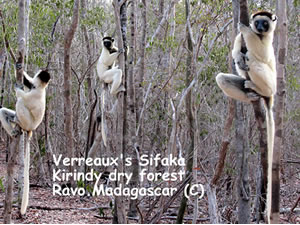
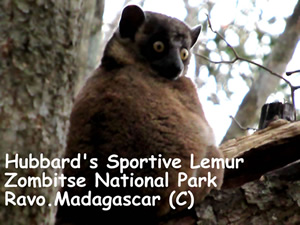
Example of day-lemurs : the Sifaka & the brown lemur
Example of nocturnal-lemurs : a sportive lemur & a mouse lemur
Kirindy deciduous seasonally dry forest - Ravo.Madagascar 2019 ©
V- Family Lemuridae ( True Lemurs : Subfamily Lemurinae
And Bamboo Lemurs = Gentle Lemurs : Subfamily Hapalemurinae ) :
True Lemurs eat leaves & fruits & they are diurnal. These lemurs spend their time in the trees. The most known are : the Lemur fulvus ( Brown lemur or Rufous lemur - With all its sub species such as the Lemur fulvus fulvus, the Lemur fulvus rufus & the Lemur fulvus albifrons ), the Varecia variegata ( Black & white ruffed lemur - in the East coast of Madagascar ) and the Lemur catta ( Ringtailed lemur ).
Lemurs that do not exhibit dormancy conserve energy by selecting thermoregulated microhabitats ( such as tree holes ), sharing nests, and reducing exposed body surfaces. Also, the Ring-tailed Lemur and ruffed lemurs are commonly seen sunning, thus using solar radiation to warm their bodies instead of metabolic heat.
Ruffed lemurs have been shown to live in " fission-fusion " societies. Lemur calls can be very loud and carry long distances. Ruffed lemurs use several loud calls that can be heard up to 1 km away.
Olfaction is particularly important to lemurs. Olfaction can communicate information about age, sex, reproductive status, as well as demarcate the boundaries of a territory. Larger, diurnal lemur species use for this olfaction scent glands located on various parts of their anatomy.
|
69- Eulemur mongoz
70- Eulemur macaco
71- Eulemur fulvus
72- Eulemur rubriventer
73- Eulemur coronatus
74- Varecia variegata
75- Varecia rubra
76- Lemur catta
77- Hapalemur griseus
78- Hapalemur simus
79- Hapalemur aureus
80- Hapalemur occidentalis
81- Hapalemur meridionalis
82- Hapalemur alaotrensis
83- Eulemur sanfordi
84- Eulemur albifrons
85- Eulemur rufus
86- Eulemur albocollaris
87- Eulemur collaris
88- Eulemur macaco flavifrons
|
Mongoose lemur
Black lemur
Common brown lemur
Red-bellied lemur
Crowned lemur
Black & white ruffed lemur
Red ruffed lemur
Ringtailed lemur
Eastern grey bamboo lemur
Greater bamboo lemur
Golden bamboo lemur
Western grey bamboo lemur
Southern grey bamboo lemur
Alaotra reed lemur
Sanford's brown lemur
White-fronted brown lemur
Red-fronted brown lemur
White-collared brown lemur
Collared brown lemur
Blue-eyed black lemur
|
Lémur mongoz
Lémur macaco
Lémur brun
Lémur à ventre rouge
Lémur couronné
Lémur vari
Vari roux
Maki
Petit hapalemur de l'Est
Grand hapalemur
Hapalemur doré
Petit hapalemur Ouest
Petit hapalemur du Sud
Hapalemur de l'Alaotra
Lémur brun de Sanford
Lémur brun au front blanc
Lémur brun FrontRouge
Lémur macaco yeuxBleu |
Contributor :
Nick Garbutt ( 2007 author ),
National Geographic,
Africa Geographic & BBC Wildlife.
Thanks alot to Dr. Mary Lou Pelaprat
from International Organization for Standardization
Black Lemur - Ravo 2013 ©
Black and White Ruffed Lemur
Robert Morgan 2003
How did Lemurs evolved ? The supercontinent Gondwana
Once part of the supercontinent Gondwana, the island of Madagascar has been isolated since it broke away from eastern Africa ( ~160 mya ), Antarctica ( ~80–130 mya ), and India ( ~90 mya ). Ancestral lemurs are thought to have originated in Africa approximately 62 to 65 mya, they would have had to have crossed the Mozambique Channel.
In 1915, paleontologist William Diller Matthew noted that the mammalian biodiversity on Madagascar ( including lemurs ) can only be accounted for by random rafting events, where very small populations rafted from nearby Africa on tangled mats of vegetation, which get flushed out to sea from major rivers. In the 1940s, American paleontologist George Gaylord Simpson coined the term " sweepstakes hypothesis " for such random events. Rafting has since been the most accepted explanation for the lemur colonization of Madagascar.
Isolated on Madagascar with only a limited number of mammalian competitors, the lemurs did not have to compete with other evolving arboreal mammalian groups. They were spared from having to compete with monkeys, which evolved later. The intelligence, aggression, and deceptiveness of monkeys gave them an advantage over other primates in exploiting the environment.
From approximately 1500 years ago until now - The subfossil lemurs
Before the arrival of humans roughly 1500 years ago, lemurs were found all across the island. However, early settlers quickly converted the forests to rice paddies and grassland through slash-and-burn agriculture ( known locally as " tavy " ), restricting lemurs to approximately 10 % of the island's area.
Habitat destruction and hunting have forced lemur populations to decline sharply, and their diversity has diminished, with the recent extinction of at least 17 species in eight genera, known collectively as the subfossil lemurs ( the Archaeoindris , the Babakotia & the Megaladapis ). Most of the approximately 99 species and subspecies of lemur are either threatened or endangered. Unless trends change, extinctions are likely to continue.
|
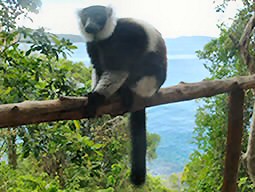  
Let's take an example :
The « Maky » = the Ringtailed lemur
The roughly 100 species of lemurs have their own habits. For example : some lemurs eat fruits & others eat insects.
The Ringtailed lemur is exclusively vegetarian
Some lemurs have 2 or 3 babies per year, others have only one per year. The mouse lemur never carries its baby on its back such as most of lemurs, but always with its teeth during 3 years. The Ringtailed lemur is always next to its baby. It has only one baby per year after 4 months and half of gestation. It carries its baby like a belt on its belly. The baby begins to search its food itself at one month. At this time, it begins too to climb a tree. But its mother continues to breastfeed it & to carry it on its back. The baby continues to be carried at the back of its mother until 6 months old. It becomes an adult at one year & half old. The Ringtailed lemur has its first sexual intercourse when it has 3 years old.
The Ringtailed lemur behavior and communication are very complicated,
They live in a group of 2 to 25 and search their food together ( fruits, flowers, leaves, barks ). The territory of one group is about 6 ha and they use strong smell to defend their own area. Females are the boss in a group. Babies are born in august & september. The Ringtailed lemur can live until 12 years old. Their enemies are falcons ( Madagascar Harrier Hawks ), dogs, cats & the biggest carnivorous in Madagascar ( the Fosa = the Cryptoprocta ferox ).
Compared to other mammals, primates in general are very vocal, and lemurs are no exception. Some lemur species have extensive vocal repertoires, including the Ring-tailed Lemur and Ruffed lemurs. Some of the most common calls among lemurs are predator alarm calls. Lemurs will not only respond to alarm calls of their own species, but also alarm calls of other species and those of non-predatory birds. The Ring-tailed Lemur and a few other species have different calls and reactions to specific types of predators.
In general, levels of aggression tend to correlate with relative canine height. The Ring-tailed Lemur has long, sharp upper canine teeth in both sexes, so it exhibits high levels of aggression.
|
Just you look a thing with attention
it becomes interesting
( Ors )
Just you know and you understand the nature
you will want protect it
( Béatrice Le Métayer )
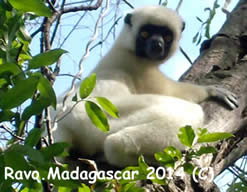
At the top : Decken's sifaka lemur
Madagascar Tour to see lemurs
Madagascar is an island of emotions. Because of its insularity, it kepts its traditions, its habits and customs, its fauna and flora with a high endemic character. I'm pleased to help you and to give you useful advice for a trip in Madagascar, to give you entire satisfaction. With my experience in tourism through Madagascar's National Parks and Reserves since ... 1993 I'm especially capable of providing all kind of travel arrangements. Please feel free to contact me for a customized itinerary ( individual tours, groups, essentials road trip, treks and adventurous trip, in luxury hotels, in tents and bivouac, etc. ).
Madagascar, a nature sanctuary, IS FAMOUS for its lemurs, for its Baobabs, and for its fauna and flora where most of them are endemic, you can not find them anywhere else.
I propose you THE BEST itinerary in just 8-days-tour ( Antananarivo airport - Antananarivo airport ) to see maximum lemurs species including THE VERY RARE Aye Aye nocturnal lemur which you will find in the nature in this Tour, it's an exceptional experience in life, an animal that you will find and take in photos only here in Madagascar.
In this Tour you will see and appreciate two different landscapes : the western dry forest and the eastern evergreen rainforest which is completely different from the first one.
With four visits :
- Kirindy dry forest (nocturnal and diurnal walks)
- The famous Baobabs Avenue at sunset and other baobabs
- Andasibe Natural Park (nocturnal and diurnal walks) and
- Palmarium lemurs Park.
The Tour can be customized for your number of people. Accomodation in extra cost.
|
|
D1: Tana - Antsirabe
Welcome at Tana airport, change then direct drive to Antsirabe
D2: Antsirabe - Kirindy
Early morning departure. Kirindy forest wildlife nocturnal walk
D3: Kirindy - Morondava
Kirindy forest a.m.
The sacred baobab, the twins-baobabs and the famous ‘Baobabs Avenue' at sunset
D4: Morondava - Antsirabe
D5: Antsirabe - Tana - Andasibe
Andasibe wildlife nocturnal walk
D6: Andasibe - Pangalanes
Andasibe Park NP a.m. to see the biggest lemur in the world. Drive and boat to the Pangalanes. Nocturnal walk to see the rare Aye Aye lemur
D7: Pangalanes - Andasibe
Palmarium lemurs Park a.m. Boat and drive back p.m.
D8: Andasibe - Tana
Drive back to Tana with a possible direct transfer to Tana airport
|
Price : 1450 Euros for 2 Persons
TAKE WITH YOU :
Anti-mosquito spray and cream, pocket torch and spare batteries, head torch if possible, light clothes as well as clothes to keep you warm ( for the nights ), cameras, small good padlocks for your luggage, your personal medicines ( current antibiotics, antidiarrhoea, antiseptics, Betadine, compresses and cotton, purifying tablets, ointment for sprains, lip salve and other personal medicines, protect yourself against malaria, e.g. follow a treatment ) sun cream, sun glasses, walking shoes or closed sports shoes, binoculars, k-way or raincoat, hat or cap, AND cash money = euros.
|
I have worked in tourism in my country since ... 1993 till now as tour guide. So ... a lot of experiences ;-)
I love my country, Madagascar. I love public relations.
I love nature. I love people. I love trips.
These passions are what makes me good at my job. Thomas Peters said: « Success at work depends on passion ». I have passionate interest in tourism. And it's a pleasure for me to invite you to visit my wonderful country : Madagascar thank you.
For more details thank you to contact me at :

Ravo, webmaster of this web site in the middle
|
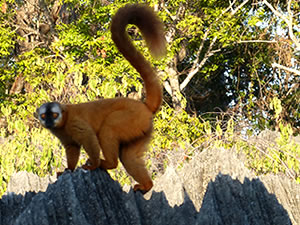 
< Common brown lemur - Indri lemur >
Clients' Testimonies after their trips in Madagascar :
• Erik Segers ( Belgium ) has written in « LinkedIn » :
If you want to discover Madagascar, Ravo is your man to organise your trip from A to Z. Thanks to his deep knowledge and boundless enthusiasm we had a truly first class visit of this wonderful island. Without a doubt, I do recommend, wholeheartedly.
• Another person has said, always in « LinkedIn » :
Ravo is an all-round tour guide and entirely devoted to his clients. Ravo will take care of everything, methodically and professionally. It’s with immense pleasure that I will ask him once more to guide me through his magnificent island, Madagascar
( Emmanuel Leborgne - Canada )

Other information about Madagascar :
Climate :
Madagascar boasts a tropical climate with more than half a year days of sunshine. The rainy season tends to be between December and March with the drier winter months occuring between May and September. There is however a considerable variation of both temperature and rainfall depending on the altitude and latitude. It is therefore possible to experience temperatures ranging from 0° in the highlands to 40° C on the West Coast.
Health :
Precautions should be taken against Malaria. Cover yourself well with mosquito repellant from dusk onwards and burn coils at night. Drink only bottled water and execrcise basic common sense when selecting restaurants/eating out. Take along a First Aid Kit, as Tana is the only city with a hospital which meets western standards.
Travel insurance :
It is essential to take out comprehensive medical travel insurance for Madagascar.
Language :
The most common language is Malagasy of which there are several dialects. French is widely spoken on the island except in the remote country areas. Some English is spoken in the larger cities especially amongst people working in tourism industry.
Power :
Power supply : 220 volt / European 2 prong plugs.
Madagascar Travel Tips :
Madagascar has been relatively isolated from the outside world. Consequently it has not been exploited by the effects of mass tourism, thus remaining one of the world's great undeveloped and undiscovered eco-tourism adventure destinations. Madagascar's tourism infrastructure is modest and unsophisticated, this being one of its many charms. Modern facilities are often not available, so having an adventurous spirit, keeping an open mind, and being willing to exercise understanding and patience, will surely assure you of a wonderful experience during your visit to this spectacular island of amazing contrasts. No one who visits the island is left unaffected, either by the warmth and hospitality of the Malagasy people, or the sheer majesty of the island's wilderness.
|
|
|
|
|
|
|
|
|
|
|
|
|
|
|
RATSIMBAZAFY Ravo Nomenjanahary
Copyright © 2000 Christian-thought
e-mail : r_ravo@hotmail.com
Tél. ++ 261 32 41 063 65

The Christian Counter
Lonesome
Tonight


Webspace Provider
|
|
|
|
|